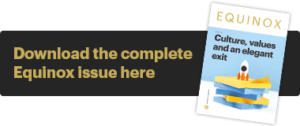On 10 August, Equilibrium celebrated 25 years in business.
Looking back, it’s been a fantastic journey of constant evolution.
The company, which started from a second-hand desk in my back bedroom, has grown from zero turnover to in excess of £10m, a team that’s approaching 100 and a brand new 23,000 sq ft office.
Whilst these numerical achievements are fantastic, those numbers taken in isolation don’t mean a great deal to me. You can have a big profitable business, but if your only focuses are the numbers and the money and they become your purpose, you can very quickly build a bad business.
There are countless stories of “bad businesses” in the press: businesses that treat their staff badly; that prioritise profit over client service; that effectively put their own interests above all else.
Over the last two-and-a-half decades, I have strived to build a business that puts its people first. If you do that, they will have the energy, expertise and enthusiasm to deliver a great service for your clients – and, if your team do that, then from a long-term perspective, the value for shareholders will increase.
As a business grows, this simple philosophy needs to grow with it and it needs to develop into a strong culture that is based on a shared purpose backed up by mutually agreed values.
If you ask me what I am most proud of over the last 25 years, it’s the culture that we have built and how every member of our team buys into our values and purpose. You could be the most productive, highly qualified member of staff but if you don’t live by our values then your career at Equilibrium will be very short lived.
Our purpose is a simple one: making people’s lives better. This applies to our staff, our clients, our community and anyone that we interact with. I believe that we can’t go far wrong if we are constantly asking ourselves the questions…
- “How can we make our clients’ lives better?”
- “How can we make life better for our team?”
And backing this up by ensuring every decision we take is guided by our four values:
- Integrity
- Growth
- Simplicity
- Excellence
The crucial issue for me is ensuring that the values and purpose actually become stronger as the business continues to grow over the decades ahead.
As Founder and the majority shareholder, I take this challenge as a personal responsibility and that is where the “BHAG” and the “elegant exit” plan comes into play.
Allow me to explain…
BHAG 2028
In 2018 we set out our BHAGs – “big hairy audacious goals”:
- Making 4,000 clients’ lives better
- Managing £4bn of assets
- Raising £4m for the Equilibrium Foundation
- Reaching a turnover of £40m
We want to achieve these goals purely through organic growth, concentrating primarily on our local area of the SK, WA and CH postcodes.
The key question though is why? What would it mean if we get there? What would happen next?
The goals came about as we realised that, at some point, we would need to consider selling some or all of the business to release the value that has been built up through, literally, a lifetime’s work.
It became clear that if we sold the business today with £1bn of assets, it was likely that the new shareholder would simply assimilate us into their business, which would result in:
- The majority of the team potentially losing their jobs or working for an employer they don’t respect
- Clients ending up with a new, much bigger and very different firm to the one they selected
- The values and purpose of Equilibrium ceasing to exist
- But, on the bright side, shareholders would get a big cheque…
Is that really an ending to a lifetime of work that I could look back on with pride and joy? 25 years of putting the needs of the team and clients first, just to throw them both under the bus at the end?
I believe that a business sale done badly can be likened to a bereavement; you lose what you love and get a big cheque in exchange.
So, we came up with a plan; if we could reach our BHAGs, we would be too big to assimilate. Any new shareholder (in part or in full) would likely retain every element of the company, and our track record of growth would be so strong that they would likely continue or maybe even expand the brand into new areas such as the Midlands and Yorkshire.
Our thinking then developed into considering what the ideal shareholder would look like and how much of the company ownership we might like to retain.
Wealth management businesses such as ourselves are currently worth in the region of 3-3.5% of assets under management. Thinking about that caused a lightbulb moment.
Let’s say that we decided to retain 30% of the business long term to demonstrate to any new shareholder our commitment going forwards. That would mean that the new shareholder(s) would be investing circa 2.5% of assets under management.
What if, rather than one big shareholder, we actually offered a private placing to our existing clients. An investment of 2.5% of their portfolios into a company they know well would be perfectly appropriate… and so, the idea of selling shares to our clients started to emerge.
We spoke with compliance consultants, lawyers and accountants and no major barriers could be foreseen.
What better way could there possibly be of making sure that our company, values and purpose continue than by having the business majority owned by our clients?
The concept for me is incredibly exciting, and so we are starting to put the outline plans and building blocks in place to make it become a reality.
There are bound to be obstacles to overcome along the way. Let’s take a look at a couple we have encountered so far…
Secondary market
We would need to make sure that clients wishing to sell their shares had a method to do so. A few ways to facilitate this would be for the company to buy back shares or to offer new clients the option of buying in, effectively creating a waiting list of potential buyers.
Valuation and due diligence
How would the clients know that the business was in good order and that the valuation of the business is fair and reasonable?
One option we are considering here is to potentially offer, say, 10% to an institutional shareholder who would invest alongside the clients and who would naturally negotiate on price and undertake all the legal due diligence which could then be shared with clients as part of the offer.
So, for instance, the ownership structure would then be 60% clients; 30% myself and the other existing minority shareholders; and 10% institutional investor, which feels like a really good mix.
Nothing would give me more pride than to be sitting here 25 years from now writing an article looking back at the last 50 years in business, reminiscing about how many lives we have made better, how the business has been protected through client ownership and how well those clients have been rewarded for their investment.
As time goes by, I would like to work a little less and, no doubt, my role in the business will change. However, I never want to retire or sell my shares in their entirety. As long as I can still add value, I will be proud to keep working.
I truly believe that the next 25 years will be even more exciting than the last, and if there is one thing I can promise, it is that the 50th birthday party will really be something to behold.
Disclaimer: The content contained in this blog represents represents the opinions of Equilibrium Investment Management LLP (EIM) and Equilibrium Financial Planning LLP (EFP). The commentary in no way constitutes a solicitation of investment advice. It should not be relied upon in making investment decisions and is intended solely for the entertainment of the viewer. Past performance is never a guide to future performance. Investments may (will) fall as well as rise and you may not get back your original investment.’




